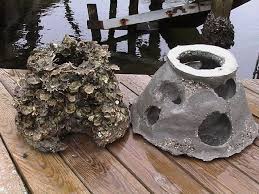These structures apparently kill two birds with one stone, providing habitat for sea life - plants and animals - at the same time as providing a guilt-free way of ridding ourselves of unwanted stuff.
A number of years ago a similar project was undertaken in Halifax harbour when large concrete balls, each weighing in the range of 1000 kg. were lowered onto the seabed.
The reef balls, in different sizes, are made of pH-neutral concrete and estimated to have a lifetime of 500 years. Some are hollow and some are ledged, providing different ways for wildlife to gain access and for water currents to eddy around them. The balls are placed in 5 to 10 metres of water - relatively shallow, so accessible by sunlight.

As shown here, algae have appropriated the concrete balls and marine habitat is well on the way to restoration. The project in Halifax harbour was financed largely by a donation from Irving Shipbuilding after they were awarded a contract to expand a shipyard.
The artificial reef project is being promoted and installed throughout parts of Atlantic Canada in hopes of making these coastal areas more friendly to marine wildlife. More information about reef balls: HERE and video HERE
Why do I have the niggling worry, though, that our parents and grandparents had the similar lofty ideas about providing habitat back in the day when sinking empty tin cans, broken bed frames and old stoves in the lake?
No comments:
Post a Comment